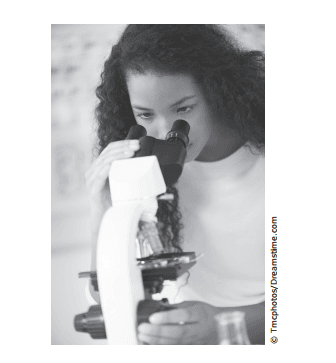
STAAR Biology High School 2017 - Past Paper
Quiz by TEKS Biology High School
High School - Biology
Science (2010)
Texas Essential Knowledge and Skills (TEKS)
Feel free to use or edit a copy
includes Teacher and Student dashboards
Measures 35 skills from
Measures 35 skills from
Track each student's skills and progress in your Mastery dashboards
With a free account, teachers can
- edit the questions
- save a copy for later
- start a class game
- automatically assign follow-up activities based on students’ scores
- assign as homework
- share a link with colleagues
- print as a bubble sheet
54 questions
Show answers
- Q1The picture shows a student using a microscope to study a prepared slide of a single-celled organism. A single-celled organism can be classified as a prokaryote based on the absence of —chromosomesa cell membranea nucleusribosomes30sB.4.A: Prokaryotic & Eukaryotic Cells
- Q2Different types of mutations can occur in DNA. The diagram represents a type of mutation. Which statement describes the mutation in the diagram?A silent mutation results in the insertion of a different amino acidA base is inserted into one strand of the DNAA deletion of a cytosine base occursA substitution occurs with the adenine base30sB.6.E: Changes In DNA
- Q3A remora is a fish that has an adhesive disk on the back of its head that it uses to attach itself to a large shark. When food floats away from the shark’s mouth as it feeds, the remora collects the scraps. Drawings of a shark with a remora attached and a remora’s adhesive disk are shown below. The relationship between the remora and the shark is an example of —competitioncommensalismpredationparasitism30sB.12.A: Biological Relationships
- Q4Invasive plant species affect the interactions of living and nonliving components of an ecosystem, so the removal of invasive plants is often necessary. The goal of most plant-control methods is to disrupt or inhibit the function of different plant systems. For example, insects can be used to chew through roots in order to reduce a plant’s ability to absorb water. Which of these functions would be most immediately affected by a reduction in water uptake by roots?Sunlight absorptionSeed dispersalPhotosynthesisDisease resistance30sB.10.B: Plant Systems
- Q5The picture shows a pika, a small mammal found in grassland ecosystems. The vast grasslands of the Tibetan plateau are home to the plateau pika. The numerous pikas are prey for many predators of the grasslands, which serve as a major watershed for much of the area. The watershed drains large quantities of groundwater during the rainy season, or the monsoon season. Pikas have extensive burrows that help drain groundwater rapidly and are used as nesting sites by many bird species. However, many people advocate the eradication of the plateau pikas because they compete with livestock for grass. Which of these will most likely happen if the plateau pikas are completely removed from the Tibetan plateau grasslands?The ecosystem will become unstable because predators will have fewer prey, the birds will have fewer nesting sites, and the area downriver will become vulnerable to flooding without the burrows to aerate the soil and provide drainage for monsoon rains.The ecosystem will become more stable because the pika will be replaced by other species of small mammals that can fill the niche, bird species will adapt to nesting aboveground, and the soils will become compacted without the burrows.The ecosystem will become more stable because the pika will no longer be there to eat the grasses, the birds will migrate to other ecosystems during nesting season, and the soils will be able to absorb more of the monsoon rains without the pika burrows.The ecosystem will become unstable because the predators will migrate to nearby ecosystems, the birds will nest in nearby trees, and the soils will be aerated by other small mammals.30sB.12.F: Environmental Change
- Q6Albinism is an autosomal recessive condition. Which circle graph shows the genotype probability when an albino female mates with a male that is heterozygous for the albinism trait?30sB.6.F: Genetic Combinations
- Q7Part of the cell cycle is shown in this simplified model. This part of the cell cycle is best described as the process that —synthesizes new moleculesmaintains genetic homeostasisduplicates the DNAcompletes cell division30sB.5.A: Cell Cycle
- Q8Taq polymerase is an enzyme used in the polymerase chain reaction (PCR) to replicate fragments of DNA. A study published in 1976 examined the properties of Taq polymerase after the enzyme was isolated from Thermus aquaticus, a thermophilic bacterium that lives in the hot springs of Yellowstone National Park. The graph shows one of the results of the study. Which statement about enzyme activity is best supported by this graph?An enzyme works equally well in bacteria that are adapted to high temperatures and in eukaryotic cells such as human cellsAn enzyme functions best under specific temperature conditionsAn enzyme must be composed of multiple polypeptides, or subunits, to be active.An enzyme’s rate of activity increases with time until it becomes inactive.30sB.9.C: Enzymes
- Q9The human immunodeficiency virus (HIV) often infects and destroys CD4 T cells. These CD4 T cells are one of many kinds of white blood cells that are an important part of the immune system. The most common danger related to the destruction of CD4 T cells is —a decrease in the flow of blood to vital organsa decrease in the amount of oxygen being transported to tissuesan increase in the threat of diseases caused by microorganisms and virusesan increase in the risk of high blood pressure30sB.4.C: Viruses
- Q10Common baboons live on the savanna in breeding groups called troops. While females tend to stay with the troop, younger or less dominant males may leave to join a neighboring troop. Which of these is a likely outcome of movement by young males?Allele frequencies suddenly changeRelative genotypic frequencies reach a constant stateIntermediate phenotypes increase in the speciesGene flow occurs between populations30sB.7.F: Evolutionary Mechanisms
- Q11An estuary collects sediments from the ocean and rivers that feed into it. The sediments swirl around and then settle to form a mudflat. Eel grass is then established on the mudflat. The ecosystem changes over time and ultimately develops into a salt marsh that contains mangrove trees. Which of the following is likely NOT involved in this example of ecological succession?The roots from plants help stabilize the sediment, keeping it in placeThe concentration of salt becomes so high that all plant life is destroyedThe soil becomes so fertile that eel grass is replaced by other plant speciesThe rotting remains of plants add to the fertility of the soil30sB.11.D: Ecological Succession
- Q12Differences in traits such as hair texture are determined by differences in —the sequence of nucleotides in DNAthe location of sugar groups in DNAthe number of nitrogenous bases in DNAthe molecules attached to the phosphate in DNA30sB.6.A: DNA Components
- Q13Students were given a list of seven elements and asked to identify the four elements that are most abundant in biomolecules. Which table correctly identifies the four most-abundant elements in biomolecules?30sB.9.A: Biomolecules
- Q14The graph shows the number of taxa of reptiles whose fossilized tracks have been found. Which statement is best supported by these data?Environmental conditions for speciation were most favorable for reptiles during the Permian periodA great extinction occurred during the Jurassic periodCompetition for food and shelter among reptile species was very low during the Triassic periodReptiles adapted to a terrestrial environment during the Cretaceous period30sB.7.B: Fossil Records
- Q15The picture shows bean-shaped glands called nodes. The clusters of cells in nodes include macrophages that break down viruses and other potentially harmful materials. Nodes also contain cells that produce protein particles capable of capturing harmful materials that flow in tissue fluid through the nodes. Different parts of the body are drained by nodes in different regions of the body. Which body systems are directly responsible for regulating these nodes and protecting the body from harmful materials in tissue fluid?Endocrine and digestive systemsCirculatory and nervous systemsImmune and lymphatic systemsDigestive and nervous systems30sB.10.A: Animal Systems
